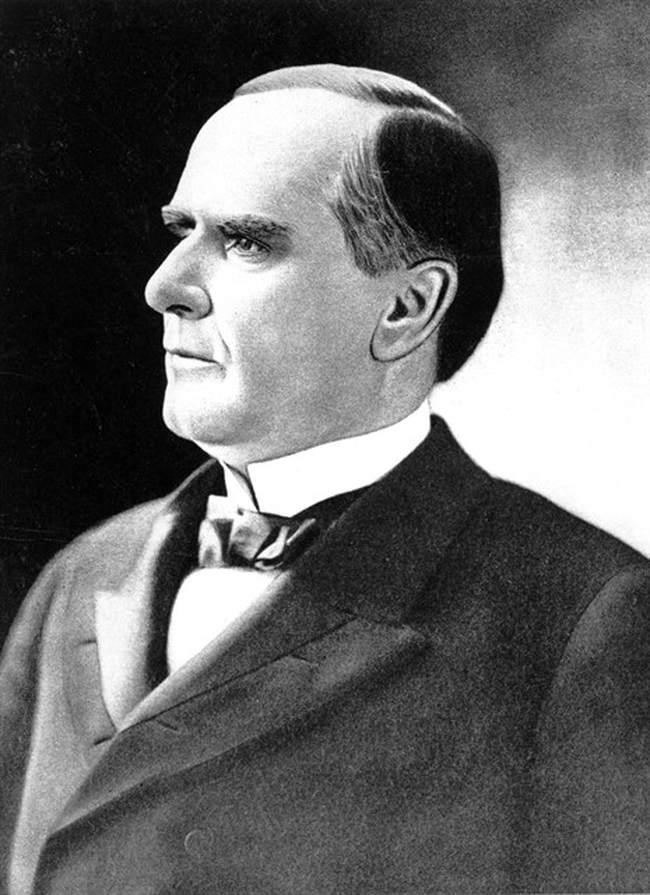
In a prior column, I referenced the fact that Donald Trump campaigned for U.S. president — and had largely governed in his prior term as president — as a moderate, Richard Nixon-style conservative.
Advertisement
Well, things have changed. As many observers have noted, Trump, today, and especially during the 2024 election, is/was promoting tariffs and protectionism, and singing the praises of his new “mentor,” former President William McKinley.
This is nothing more than a return to the old GOP. McKinley was more vocal about protectionism than most, but all Republican presidents had been favorable to it, from the first Republican president, Lincoln, to McKinley. (Reagan-like conservatives who tended to favor freer trade came to the forefront starting under Warren Harding in 1920.)
McKinley was a two-term Republican president who served from 1897 to 1901. (His second term was abbreviated by his assassination by a leftist anarchist, Leon Czolgosz.) McKinley established the most durable GOP political alignment ever for the U.S. presidency. Prior to his victory in 1896, the two parties had been nip and tuck in the race for president, sometimes winning by popular pluralities and sometimes winning electorally while losing the popular vote. But in 1896, McKinley won with 51 percent of the national vote, and then he grew to win re-election with 52 percent; both times, he solidly carried the Electoral College. In 1904, his vice president, Theodore Roosevelt, won a term with 56 percent and also an overwhelming electoral victory. In 1908, William Howard Taft, Roosevelt’s chosen successor, won 52 percent of the vote and with another huge electoral margin. And in 1912, when Roosevelt challenged Taft as a third-party candidate, Roosevelt won 27 percent to Taft’s 23 percent, with the two Republicans combining to earn 50 percent of the national vote, eight points higher than the Electoral College winner, Democrat Woodrow Wilson.
Advertisement
McKinley’s political skills were so impressive that Karl Rove himself, former President George W. Bush’s political consigliere, identified with him as well, and particularly with McKinley’s campaign guru, Mark Hanna, whom he wanted to be his own “mentor.” (Unfortunately for Rove, according to his own standards, the Bush alignment completely failed to follow in the successful footsteps of the McKinley alignment.)
As Rove wrote in his book on President McKinley (which I heartedly recommend as an interesting and informative read), McKinley:
was a different kind of Republican who felt that the GOP must broaden its base. It was losing strength because the North was becoming less Anglo-Saxon Protestant and Southern Democrats were extinguishing the voting rights of Republican blacks. The GOP would win national elections only if it gained support from new ethnic immigrant laborers in the North – often Catholic – while finding a way to defend free and fair elections below the Mason-Dixon Line and attract more votes there by emphasizing protection.
As the 1896 and 1900 elections showed, McKinley’s muscular protectionism, coupled with his stance in opposition to the silver monetary issue promoted by Democrat William Jennings Bryan, led directly to this stronger GOP national coalition. As Rove wrote, “Protectionism united Republicans, split Northern Democrats, and attracted the laborer vote, a swing bloc that neither party dominated.”
Advertisement
Note that McKinley was an exceptionally successful politician overall. He won two presidential races; two terms as Ohio governor; seven terms in the U.S. House of Representatives, and only “lost” two other House races because he was gerrymandered out of that office (and one of those elections he had actually won, but was denied his seat by the Democrat House majority); and one term as prosecuting attorney of Stark County (which prior to his election had been heavily Democrat; he lost his re-election by only 143 votes). And in all of his races, McKinley was always known as the “Napoleon of Protection.”
Pale, Senile, and Not Ready: Joe Biden Embarrasses Himself While Gaslighting on Tariffs
Now, let’s return to the current time. I believe that the 2024 election is another realigning election. For those who are unfamiliar, a realigning election – it is actually a series of elections, so in this case, it is 2016, 2020, and 2024 – is a rare, significant, long-term change in the voting behavior and party identification of the American electorate. A realignment tends to happen every 30 years or so, as a critical number of voters die off and are replaced by new voters who might change their voting behavior from their voting predecessors. Realignments are characterized by new issues becoming important (“salient”) and ethnic, religious, and other groupings shifting in the partisan vote.
Advertisement
As noted political pollster Patrick Ruffini has written about 2024:
2024 was as much a “realigning” election as 2016, with just as big if not bigger shifts in the educational and class makeup of the parties. The Harris coalition looks more like Bob Dole’s 1996 coalition than the Obama coalition. And for the first time, the Republicans represent both low-education and low-income voters, in a thoroughgoing working class realignment.
In the 2024 election, Donald Trump also won increasing numbers of the minority vote, including African Americans, Hispanics, Jewish Americans, and Asian Americans. In prior elections, he had showed increasing appeal to gay Americans as well.
There is no question that Trump’s appeal to many of these minority voters and the white working class was helped by his promotion of protectionism and tariffs in his presidential races, especially in 2024. (Although there were other factors as well.) I believe that Donald Trump and his political advisors are hoping to secure a viable GOP-dominant alignment for (presumably) the next 30 years or so, based on this issue and based on the resurrection of political McKinleyism.
We shall all get to see if the Trump administration succeeds.
PS: Please note, in this column, I am not interested in debating the merits of protectionism and tariffs. That type of paper is better left to the experts at the Heritage Foundation and other economic think tanks.
Advertisement

